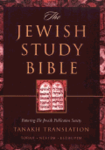As we continue profiling the Study Bibles from this month’s sale, today we will take an at-a-glance look at the Jewish Study Bible.
Title: The Jewish Study Bible
Area of Focus: Jewish Studies
Contributors: Edited by Adele Berlin and Mard Zvi Brettler
Description: The Jewish Study Bible is designed to meet the needs of those seeking to study the Hebrew Bible from the Jewish perspective. The JSB draws from various schools of Jewish traditions of biblical exegesis (rabbinic, medieval, mystical, etc.) and is based out of the Jewish Publication Society TANAKH Translation. Features include book introductions, running commentary, essays that address Judaism’s use and interpretation of the Bible, and more.
Sample Essay: The Bible in the Synagogue
During the period of the Second Temple (from the return to Zion [538 BCE] until the destruction of the Temple [70 CE]), and in particular after the conquest of the entire Near East by the armies of Alexander the Great (ca. 330 BCE), numerous upheavals occurred in the religious–spiritual world of the Jewish people. Two of the fundamental changes caused by these upheavals are important for our discussion, having left their mark on Judaism, in all places, in every era, and upon the various forms of Jewish expression, up to the present day: the growth and establishment of the synagogue, and the central role played by the Bible in the religious and spiritual existence of the Jewish people. Since then, a Jewish community without a synagogue at its center is unimaginable, nor could one conceive of a synagogue in which a central place was not reserved, both physically and in terms of its activities, for the three sections of the Tanakh: the Torah, the Prophets, and the Writings.
During the era of the First Temple (until its destruction in 586 BCE), and to some extent during the ensuing two or three centuries, the word of God was perceived to be revealed to humanity in numerous ways. First and foremost, it came through the prophet through whom God revealed His will or His plans. God also answered the people’s questions, both by way of the priests, using the Urim and Thummim, as well as through dreams (see 1 Sam. 28:6: “But the LORD did not answer him, either by dreams or by Urim or by prophets”). Thus the prophet, the priest, and the interpreter of dreams served as intermediaries between God and human beings. In this respect, a major upheaval occurred when it was believed that prophecy had departed from Israel after the prophets Haggai, Zechariah, and Malachi (b. B. Bat. 14b), that the Urim and Thummim had disappeared (y. Mak. 5:2), and that dreams are not divine messages from heaven but a result of human self–reflection (b. Ber. 55b). All of these methods of discovering the divine will were then replaced by texts, the Holy Scriptures. The nation of Israel became what was later termed the “People of the Book.” The intermediary between God and humanity was henceforth the Rabbi, the wise man who knew how to read Scriptures and to hear through them God’s voice. Instead of one–time divine revelations through dreams or prophets or priests, the Jewish people were given a book which was understood to contain God’s revelation for all time. The era of revelation to individuals at appointed times came to a close, and was replaced by a new era with continuous revelation for all, by way of the Holy Scriptures. From this point on, the religion and culture of Israel developed around the twenty–four books of the Tanakh: in Houses of Study and in schools, at particular events such as eulogies or festive religious celebrations, but first and foremost in the synagogues…


